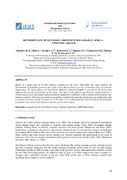| dc.contributor.author | Ndambiri, H.K | |
| dc.contributor.author | Ritho, C. | |
| dc.contributor.author | Ng'ang'a, S.I | |
| dc.contributor.author | Kubowon, P.C. | |
| dc.contributor.author | Mairura, F.C. | |
| dc.contributor.author | Nyangweso, P.M. | |
| dc.contributor.author | Muiruri, E.M. | |
| dc.contributor.author | Cherotwo, F.H. | |
| dc.date.accessioned | 2015-10-09T13:16:32Z | |
| dc.date.available | 2015-10-09T13:16:32Z | |
| dc.date.issued | 2012 | |
| dc.identifier.uri | http://karuspace.karu.ac.ke/handle/20.500.12092/1861 | |
| dc.description.abstract | Based on a panel data of 19 Sub Saharan countries for the years 1982-2000, this study explores the determinants of economic growth in the region. Given that economic growth is essentially seen as a dynamic phenomenon, the study employs the Generalized Method of Moments (GMM) to account for the factors that influence the growth of economies in the region. The study results indicate that physical capital formation, a vibrant export sector and human capital formation significantly contribute to the economic growth among sub- Saharan countries. However, government expenditure, nominal discount rate and foreign aid significantly lead to negative economic growth. As found out in the study, it is recommended that relevant policies be formulated to promote those sectors that enhance economic growth in the region | en_US |
| dc.language.iso | en | en_US |
| dc.publisher | International Journal of Economics and Management Sciences | en_US |
| dc.subject | economic growth, sub Saharan Africa, dynamic panel data, GMM methodology | en_US |
| dc.title | DETERMINANTS OF ECONOMIC GROWTH IN SUB-SAHARAN AFRICA: A Panel Data Approach | en_US |
| dc.type | Article | en_US |
